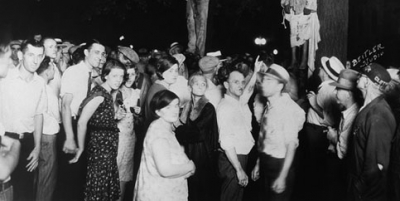Courthouse in Marion, Indiana, 1908
From the Indy Scribe, "Book Review: Our Town: A Heartland Lynching, a Haunted Town, and the Hidden History of White America,"by Steph Mineart (14 Aug 2006):
On August 7, 1930, the courthouse square in Marion, Indiana was the location of one of the most shocking events in the town's history -- the lynching of two young black men who were dragged from the city jail and brutally beaten before being hung from a tree in the square. A third young man escaped being lynched to tell the tale. Because of him, and because of an infamous photo of the scene showing hundreds of perpetrators and spectators viewing the crime, (a photo that was sold by the thousands in the days after) the event has never been forgotten, although it is spoken of rarely and with trepidation amongst the residents of the town. Journalist Cynthia Carr, who grew up in Marion and who's family has a long history there, set out to examine that event, the history of race relations in Indiana that led up to it, and the unspoken resonance from it that has haunted the town every since.
Courthouse in Marion, Indiana, 1930
Every family in 1930s Marion had some sort of personal connection -- directly or indirectly -- to the lynching, and Carr's family is no exception, so her investigation of her town's history often takes a turn to the personal and reflective. Her willingness to confront that connection is clearly unusual in a town where residents both black and white just want the whole history to disappear into the mists of time -- a sentiment that is really the exact reason why the story just won't do so.

Carr also reconstructs another compelling story -- Indiana's own history of the relationship between black folks and white folks. Prior to the civil war, Indiana had a strong history of abolitionism and activity on the underground railroad, but during reconstruction that history was virtually forgotten with the rise of the Ku Klux Klan in Indiana. It's estimated that during the 1920's one in every three white men was a part of the Klan, and Indiana was also home to numerous "sun down" towns -- where signs at the city limits warned black people not to let the sun go down on them in that town. Grand Dragon D.C. Stephenson's arrest in 1925 is often referred to as the event that "broke the back of the Klan" in Indiana, and it did mark a turning point in the popularity of the Klan, but the racist organization has never really disappeared from the state.
Carr was able to uncover the evidence of what role they played in the 1930 lynching and throughout Indiana's history. To understand the effects of racism even in the present day, and to uncover the extent of the KKK's influence today (some Marion residents wouldn't talk to her about the lynching for fear of retaliation from the Klan), Carr infiltrates the modern Klan and contrasts their current movement with past. (source: Indy Scribe)

According to the UK Guardian's Obituary, "James Cameron: American civil rights campaigner who survived a lynching," by Phil Davison on 26 July 2006 -- In 1930, James Cameron was a 16-year-old black boy, held in an Indiana jail after the murder of a white man, and an alleged rape, when a mob led by hooded Ku Klux Klan members stormed the prison, beat him and put a rope around his neck. They led him to a nearby elm tree where the bodies of two older black teenagers, his friends, were already hanging, an image immortalized in an infamous, disturbing photograph showing smiling onlookers.

A crowd of 2,000 white people called for Cameron to be strung up. Then, as he recounted in his 1982 autobiography, A Time of Terror, an "angelic voice" called out: "Take this boy back. He doesn't have anything to do with any shooting or raping." The crowd relented and he was led back to jail: "Slowly, painfully, I started limping back towards the jail, dragging myself as best I could. Each step was a prayer and each prayer was a 'thank you, Jesus!' No one touched me on the way. No one called out any angry epithets. I looked into the faces as I limped along. They were tired, serious faces now, with shame in their eyes."

Cameron, who has died aged 92, admitted he had been at the murder scene in Marion, Indiana, with two older friends, but said he had fled out of fear before the shooting. He was found guilty of robbery and being an accessory to manslaughter, and spent more than four years in jail before becoming known as the US's only lynching survivor. It was only last year that the Senate apologised for not enacting laws to prevent the lynchings of 4,700 people from the 1880s until as late as 1968.

Cameron was an active civil rights campaigner most of his life, marching with Martin Luther King Jr and with the Rev Jesse Jackson. During a visit to the Yad Vashem museum in Jerusalem in 1979, he became determined to open a museum to what he called the "black holocaust", to ensure that the horrors of slavery never be forgotten.

James Cameron, civil rights campaigner, born February 23 1914; died June 11 2006.
In 1988, at the age of 74, he opened the Black Holocaust Museum in the basement of his home in Milwaukee, Wisconsin. One of its most moving items is a piece of the rope from that night in Marion. Initially he ran the museum alone, but it later moved to its current location in Milwaukee, in a former gymnasium sold to him by the city for a token $1.
Cameron was born in La Crosse, Wisconsin, and moved with his mother to Marion in 1928. He is survived by his wife, Virginia, two sons and a daughter. (source: The UK Guardian's Obituary)


No comments:
Post a Comment